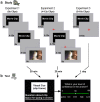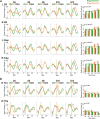Constructing realistic engrams: poststimulus activity of hippocampus and dorsal striatum predicts subsequent episodic memory
- PMID: 21677186
- PMCID: PMC6622928
- DOI: 10.1523/JNEUROSCI.0702-11.2011
Constructing realistic engrams: poststimulus activity of hippocampus and dorsal striatum predicts subsequent episodic memory
Abstract
Encoding of real-life episodic memory commonly involves integration of information as the episode unfolds. Offline processing immediately following event offset is expected to play a role in encoding the episode into memory. In this study, we examined whether distinct human brain activity time-locked to the offset of short narrative audiovisual episodes could predict subsequent memory for the gist of the episodes. We found that a set of brain regions, most prominently the bilateral hippocampus and the bilateral caudate nucleus, exhibit memory-predictive activity time-locked to the stimulus offset. We propose that offline activity in these regions reflects registration to memory of integrated episodes.
Figures







References
-
- Axmacher N, Elger CE, Fell J. Ripples in the medial temporal lobe are relevant for human memory consolidation. Brain. 2008;131:1806–1817. - PubMed
-
- Baddeley A. The episodic buffer: a new component of working memory? Trends Cogn Sci. 2000;4:417–423. - PubMed
-
- Brewer JB, Zhao Z, Desmond JE, Glover GH, Gabrieli JD. Making memories: brain activity that predicts how well visual experience will be remembered. Science. 1998;281:1185–1187. - PubMed
-
- Buzsáki G. Two-stage model of memory trace formation: a role for “noisy” brain states. Neuroscience. 1989;31:551–570. - PubMed
Publication types
MeSH terms
Substances
LinkOut - more resources
Full Text Sources
